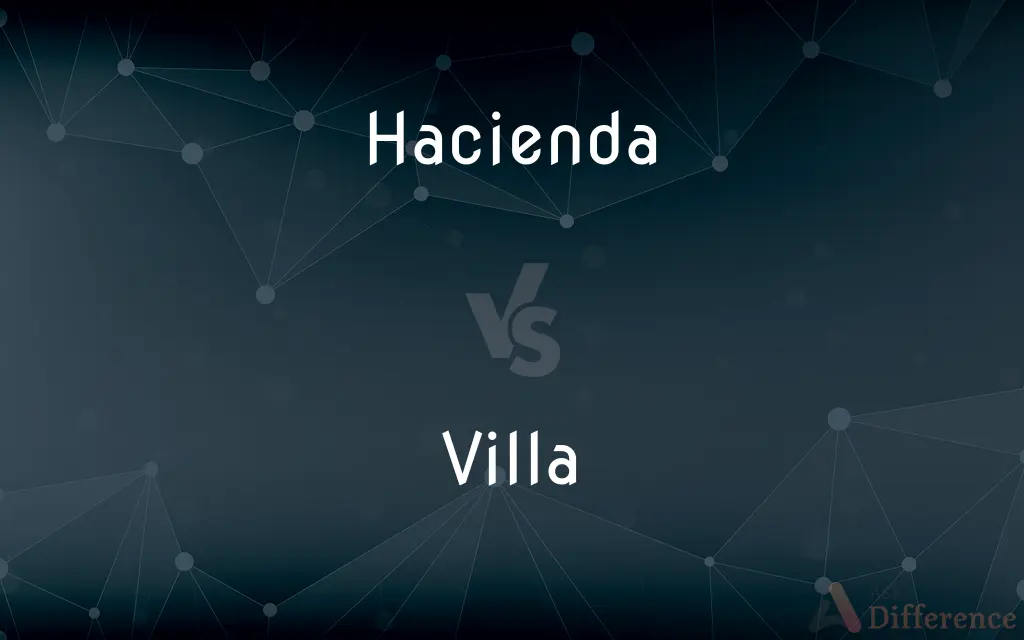Hacienda vs. Villa — What's the Difference?
By Fiza Rafique & Maham Liaqat — Updated on March 28, 2024
A hacienda typically refers to a large estate or plantation with a dwelling house, prevalent in Latin America, while a villa is a luxurious, often spacious, country house in Europe.

Difference Between Hacienda and Villa
Table of Contents
ADVERTISEMENT
Key Differences
Haciendas are large agricultural estates that were historically significant in the colonial economies of Latin America, often associated with a specific residence for the landowner and laborers' quarters, emphasizing their role in agriculture and ranching. Villas, on the other hand, originated in ancient Rome as upper-class country homes and have evolved into luxurious residences, often used as retreats in the countryside or in suburban areas, highlighting their association with leisure and affluence.
While haciendas were central to the production of commodities like sugar, coffee, and cattle, and played a key role in local economies and societies, villas have been traditionally seen as symbols of luxury and leisure, reflecting the wealth and taste of their owners. This difference underscores the hacienda's focus on agricultural production and the villa's emphasis on comfort and architectural beauty.
Architecturally, haciendas are known for their functional design to support agricultural operations, often featuring courtyards, thick walls, and sometimes, fortifications. Villas are characterized by their architectural elegance, including landscaped gardens, ornate designs, and amenities for leisure, such as swimming pools and large entertaining areas.
The cultural significance of haciendas and villas also differs; haciendas are deeply intertwined with the colonial history and agrarian societies of Latin America, whereas villas are often associated with the leisurely lifestyle of the European elite, reflecting different historical and social contexts.
Comparison Chart
Origin
Latin America
Europe
ADVERTISEMENT
Primary Function
Agricultural production
Leisure and luxury residence
Historical Significance
Integral to colonial economy and society
Symbol of wealth and luxury
Architectural Features
Courtyards, thick walls, functional design
Ornate designs, landscaped gardens, amenities for leisure
Cultural Significance
Reflects agrarian societies and colonial history
Associated with elite leisure and architectural beauty
Compare with Definitions
Hacienda
Historically, served as the center for agricultural and ranching operations.
The hacienda had extensive cattle ranching areas along with sugar cane fields.
Villa
Originated as upper-class Roman country homes.
The ruins of an ancient Roman villa show the luxurious lifestyle of its inhabitants.
Hacienda
Often has a central courtyard as a feature.
The family gathered in the hacienda's courtyard for celebrations.
Villa
A luxurious country house in Europe, often used as a retreat.
They spent their summer at a beautiful villa in Tuscany.
Hacienda
Reflects the social and economic history of colonial Latin America.
The old hacienda has been preserved as a museum to showcase the area's history.
Villa
Can be found in suburban or rural settings, offering privacy and luxury.
Their modern villa overlooks the Mediterranean, offering breathtaking views.
Hacienda
A large estate or plantation with a dwelling house, primarily in Latin America.
The hacienda produced most of the region's coffee.
Villa
Features elegant architecture and landscaped gardens.
The villa's gardens were designed by a famous landscape architect.
Hacienda
Features architecture designed for practicality and operation.
The hacienda's thick walls kept the interiors cool during the hot summers.
Villa
Serves as a symbol of affluence and leisure.
Owning a villa on the lake is a sign of wealth and good taste.
Hacienda
A hacienda (UK: or US: ; Spanish: [aˈθjenda] or [aˈsjenda]), in the colonies of the Spanish Empire, is an estate (or finca), similar to a Roman latifundium. Some haciendas were plantations, mines or factories.
Villa
A villa is a type of house that was originally an ancient Roman upper-class country house. Since its origins in the Roman villa, the idea and function of a villa has evolved considerably.
Hacienda
A large estate in a Spanish-speaking region.
Villa
(especially in continental Europe) a large and luxurious country house in its own grounds.
Hacienda
The house of the owner of such an estate.
Villa
A large country house of Roman times, having an estate and consisting of farm and residential buildings arranged around a courtyard.
Hacienda
A large homestead in a ranch or estate usually in places where Colonial Spanish culture has had architectural influence.
Villa
The often large, luxurious country house of a well-to-do person.
Hacienda
A large estate where work of any kind is done, as agriculture, manufacturing, mining, or raising of animals; a cultivated farm, with a good house, in distinction from a farming establishment with rude huts for herdsmen, etc.; - a word used in Spanish-American regions.
Villa
A country estate with a substantial house.
Hacienda
The main residence of a hacienda{1}.
Villa
Chiefly British A house in a middle-class suburb.
Hacienda
A large estate in Spanish-speaking countries
Villa
(plural "villas") A house, often larger and more expensive than average, in the countryside or on the coast, often used as a retreat.
Hacienda
The main house on a ranch or large estate
Villa
A family house, often semi-detached, in a middle class street.
Villa
A country house, with farm buildings around a courtyard.
Villa
A country seat; a country or suburban residence of some pretensions to elegance.
Villa
Mexican revolutionary leader (1877-1923)
Villa
Detached or semi-detached suburban house
Villa
Country house in ancient Rome consisting of residential quarters and farm buildings around a courtyard
Villa
Pretentious and luxurious country residence with extensive grounds
Common Curiosities
What is the primary purpose of a hacienda?
A hacienda serves primarily as an agricultural estate, focusing on production and sometimes ranching.
How does the function of a villa differ from that of a hacienda?
A villa functions as a luxurious residence, emphasizing leisure, comfort, and architectural beauty.
Can villas be found outside of Europe?
Yes, while villas originated in Europe, the concept has been adopted worldwide to describe luxurious country homes.
Can haciendas be used for purposes other than agriculture today?
Yes, many haciendas have been repurposed into hotels, museums, or residential homes, preserving their historical significance.
Are all haciendas large and expansive?
While haciendas are typically large, the size can vary depending on their location and the specific agricultural activities they supported.
What historical era is most associated with haciendas?
Haciendas are most associated with the colonial era in Latin America, reflecting their role in the colonial economy.
Do modern villas maintain the same architectural styles as ancient Roman villas?
Modern villas often incorporate contemporary design elements, but many maintain the classical influence with luxurious amenities and landscaped gardens.
Is the term 'villa' used in the same context globally?
While the term 'villa' has a specific historical context in Europe, globally, it may refer to any detached or semi-detached luxury house.
How did haciendas impact local societies in Latin America?
Haciendas had a significant impact on local economies, social structures, and cultures, often shaping the development of rural areas.
What makes a villa luxurious?
The luxury of a villa is defined by its location, architectural design, amenities, and the extent of its landscaped grounds.
Share Your Discovery

Previous Comparison
Untrue vs. False
Next Comparison
Dizzy vs. FaintAuthor Spotlight
Written by
Fiza RafiqueFiza Rafique is a skilled content writer at AskDifference.com, where she meticulously refines and enhances written pieces. Drawing from her vast editorial expertise, Fiza ensures clarity, accuracy, and precision in every article. Passionate about language, she continually seeks to elevate the quality of content for readers worldwide.
Co-written by
Maham Liaqat















































